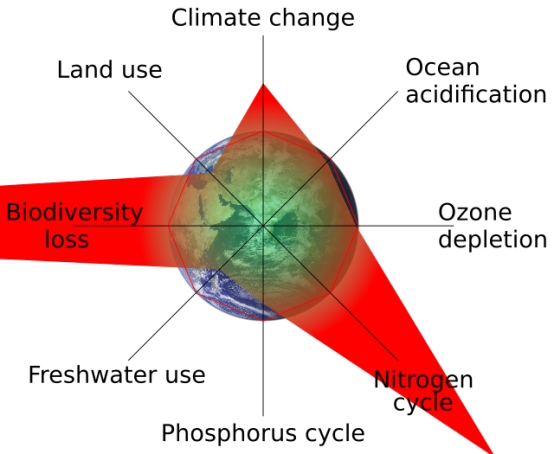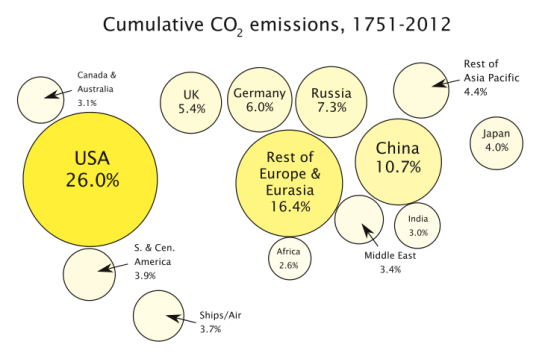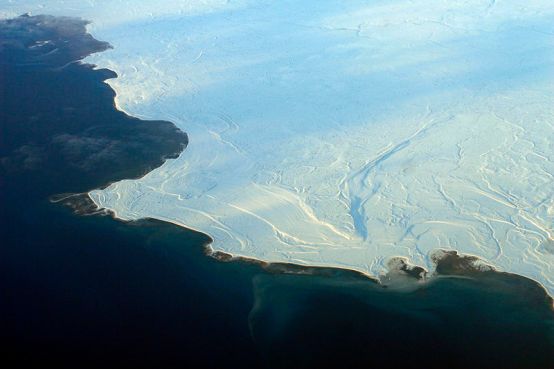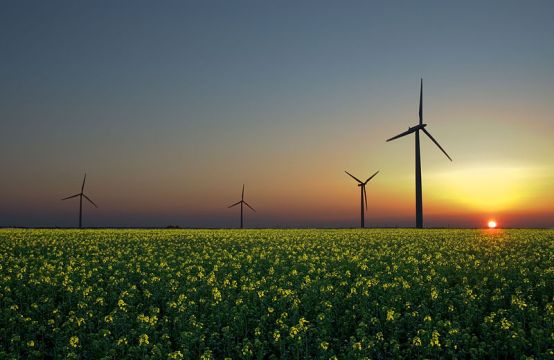By John Scales Avery*
15 June 2015 – Exponential growth of any quantity with time has some remarkable characteristics, which we ought to try to understand better, since this understanding will help us to predict the future. The knowledge will also show us the tasks which history has given to our generation. We must perform them with urgency in order to create a future in which our descendants will be able to survive.
If any quantity, for example population, industrial production or indebtedness, is growing at the rate of 3% per year, it will double in 23.1 years; if it is growing at the rate of 4% per year, the doubling time is 17.3 years.
For a 5% growth rate, the doubling time is 13.9 years, if the growth rate is 7% (the rate of economic growth that China’s leaders hope to maintain), the doubling time is only 9.9 years. If you want to find out the doubling time for any exponentially growing quantity, just divide 69.3 years by the growth rate in percent.
Looking at the long-term future, we can calculate that any quantity increasing at the modest rate of 3% per year will grow by a factor of 20.1 in a century.
This implies that in four centuries, whatever is growing at 3% will have increased by a factor of 163,000. These facts make it completely clear that long-continued economic growth on a finite planet is a logical absurdity.
Yet economists and governments have an almost religious belief in perpetual economic growth. They can only maintain this belief by refusing to look more than a short distance into the future.
***Percentage share of global cumulative energy-related CO2 emissions between 1751 and 2012 across different regions. | Author: Enescot | Wikimedia Commons
Exponential decay of any quantity follows similar but inverse rules. For example, if the chance of a thermonuclear war will be initiated by accident or miscalculation or malice is 3% in any given year, the chance that the human race will survive for more than four centuries under these conditions is only1 in 163,000, i.e. 0.000625 percent.
Clearly, in the long run, if we do not completely rid ourselves of nuclear weapons, our species will have little hope of survival.
Besides nuclear war, the other great threat to the survival of the human species and the biosphere is catastrophic climate change. The transition to 100% renewable energy must take place within about a century because fossil fuels will become too rare and expensive to burn.
****Sea ice, shown here in Nunavut, in northern Canada, reflects more sunshine, while open ocean absorbs more, accelerating melting. | Author: Doc Searls from Santa Barbara, USA | Wikimedia Commons
But scientists warn that if the transition does not happen much faster than that, there is a danger that we may reach a tipping point beyond which feedback loops, such as the albedo effect and the methane hydrate feedback loop, could take over and produce an out-of-control and fatal increase in global temperature.
In 2012, the World Bank issued a report warning that without quick action to curb CO2 emissions, global warming is likely to reach 4 degrees C during the 21st century. This is dangerously close to the temperature which initiated the Permian-Triassic extinction event: 6 degrees C above normal. \
During the Permian-Triassic extinction event, which occurred 252 million years ago. In this event, 96 percent of all marine species were wiped out, as well as 70 percent of all terrestrial vertebrates.
*****Wind, solar, and biomass are three emerging renewable sources of energy. | Wind turbines in a rapeseed field in Sandesneben, Germany. | Author: Jürgen from Sandesneben, Germany | Wikimedia Commons
Is a quick transition to 100% renewable energy technically possible? The remarkable characteristics of exponential growth can give us hope that it can indeed be done, provided that we make the necessary effort.
The Earth Policy Institute recently reported that “Between 2008 and 2013, as solar panel prices dropped by roughly two thirds, the PV installed worldwide skyrocketed from 16,000 to 139,000 megawatts…
In its January 2014 solar outlook report, Deutsche Bank projected that 46,000 megawatts would be added to global PV capacity in 2014 and that new installations would jump to a record 56,000 megawatts in 2015.” https://mail.google.com/mail/?shva=1#inbox/14de86413c154197
An analysis of the data given by the Earth Policy Institute shows that global installed photovoltaic capacity is now increasing by 27.8% per year.
Because of the remarkable properties of exponential growth, we can predict that by 2034, the world’s installed PV capacity will have reached 47.7 terawatts, more than twice today’s global consumption of all forms of energy (provided, of course, that the present rate of growth is maintained).
We can see from this analysis, and from data presented by Lester Brown and his coauthors Janet Larsen, Mathew Roney and Emily Adams, in their recent book “The Great Transition”, that the urgently-needed replacement of fossil fuels by renewable energy is technically achievable.
But it also requires political will. For example the present rapid rate of growth of global PV capacity was initiated by the German government’s enlightened financial policies. Government measures helping renewables are vital.
At present, governments give billions in direct and indirect support of fossil fuel giants, which in turn sponsor massive advertising campaign to convince the public that anthropogenic climate change is not real. Our task, for the sake of future generations, is to provide the political will needed for the great transition.
http://www.earth-policy.org/books/tgt
http://eruditio.worldacademy.org/issue-5/article/urgent-need-renewable-energy
For the sake of future generations, let us also work with dedication for the great transition to a world without nuclear weapons, a world without war, and a world with an economic system that does not depend on growth.
—
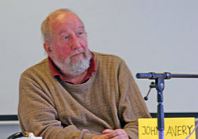 *John Scales Avery, Ph.D., who was part of a group that shared the 1995 Nobel Peace Prize for their work in organizing the Pugwash Conferences on Science and World Affairs, is a member of the TRANSCEND Network and Associate Professor Emeritus at the H.C. Ørsted Institute, University of Copenhagen, Denmark.
*John Scales Avery, Ph.D., who was part of a group that shared the 1995 Nobel Peace Prize for their work in organizing the Pugwash Conferences on Science and World Affairs, is a member of the TRANSCEND Network and Associate Professor Emeritus at the H.C. Ørsted Institute, University of Copenhagen, Denmark.
He is chairman of both the Danish National Pugwash Group and the Danish Peace Academy and received his training in theoretical physics and theoretical chemistry at M.I.T., the University of Chicago and the University of London. He is the author of numerous books and articles both on scientific topics and on broader social questions. His most recent book is Civilization’s Crisis in the 21st Century http://www.learndev.org/dl/Crisis21-Avery.pdf.
Other articles by John Scales Avery published by Human Wrongs Watch:
Albert Einstein, Scientist and Pacifist
“The Path to Zero: Dialogues on Nuclear Dangers”, by Richard Falk and David Krieger
Millay’s “Epitaph for the Race of Man”
The Future of International Law (Part I)
The Future of International Law (Part II)
The Future of International Law (Part III)
Europe Must Not Be Forced Into a Nuclear War with Russia
Tactical Nuclear Weapons in Europe – The Dangers Are Very Great Today
Why Is the Total Elimination of Nuclear Weapons So Urgent?
Why Is the Military-Industrial Complex Sometimes Called “The Devil’s Dynamo”?
Adam Smith’s Invisible Hand Is at Our Throats
Does It Make Sense to Saw Off the Branch on Which You Are Sitting?
Blood for Oil – The Close Relationship Between Petroleum and War
—
Images:
**Map showing where natural disasters caused/aggravated by global warming may occur. | Author: KVDP | Wikimedia Commons
***Percentage share of global cumulative energy-related CO2 emissions between 1751 and 2012 across different regions. | Author: Enescot | Wikimedia Commons
****Sea ice, shown here in Nunavut, in northern Canada, reflects more sunshine, while open ocean absorbs more, accelerating melting. | Author: Doc Searls from Santa Barbara, USA | Wikimedia Commons
*****Wind, solar, and biomass are three emerging renewable sources of energy. | Wind turbines in a rapeseed field in Sandesneben, Germany. | Author: Jürgen from Sandesneben, Germany | Wikimedia Commons
2015 Human Wrongs Watch


